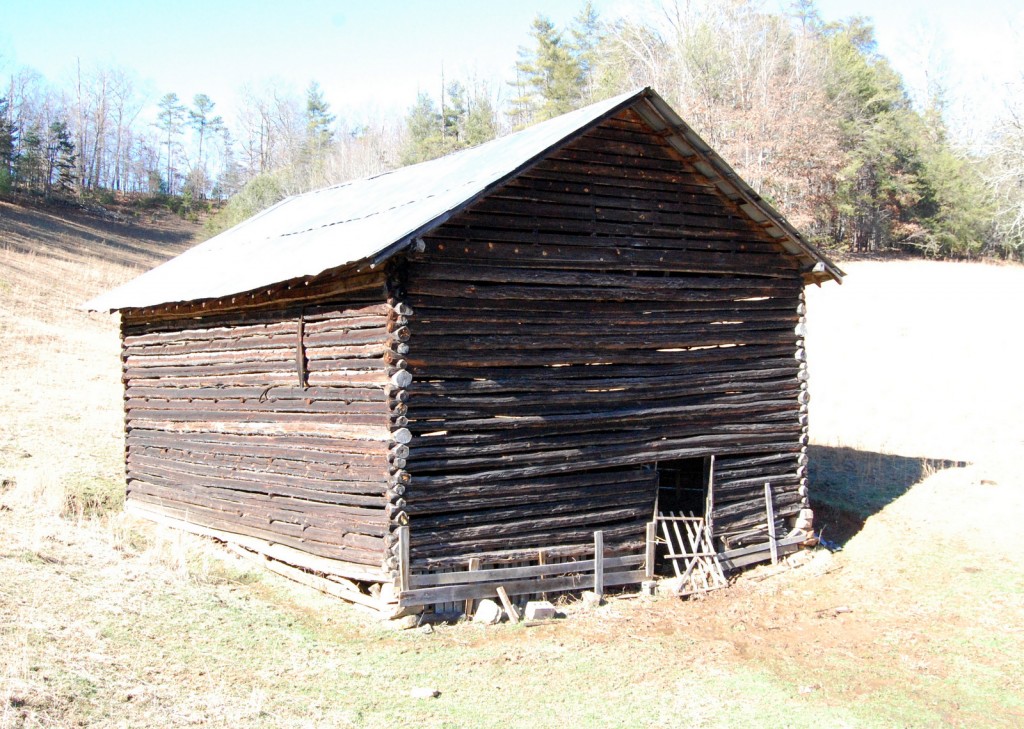Mystery Barn Eludes Explanation By Taylor Barnhill
Appeared in the New Record Sentinel February 20, 2013
Anyone who has turned onto Walker Branch Road where it meets Paint Fork Road in the Beech Glen township has probably noticed the large log barn standing far up a draw in the rolling steep pasture. Even at a thousand feet distance it’s easy to make out the dark weathered logs that frame this barn. Most of us would recognize this as one of Madison County’s thousands of burley tobacco barns, but upon closer look it reveals a number of interesting mysteries.
This barn is one of several built by the D. Nelson Anderson family whose earliest ancestors purchased land on Paint Fork Creek in 1797. Most of our generation know this farm as that of Oscar Anderson, Sr. and Oscar Anderson, Jr. The beautiful house there, built in 1890, is still the home of Mrs. Oscar Anderson, Jr.
What is the origin of this unusual barn? Family members do not know when this log barn was built, but know that it is very old and has always been used exclusively for tobacco. Madison County enjoyed two different eras of commercial tobacco farming: the early flue-cured tobacco that began around 1887, and the better-known burley tobacco that began in the 1920s and ended as a federally supported program in 2004. Some burley tobacco is still grown in Madison County.
The large log barn on Paint Fork Road is currently being used as a burley barn, but there are some odd features of this barn that make you wonder if it may have been originally built for another purpose. Burley tobacco is air-cured with full stalks of tobacco hanging from sticks that are then hung from tier poles spaced around forty-eight inches both horizontally and vertically. The walls of a burley barn are built to allow unobstructed air flow through the hanging tobacco plants throughout the drying period.
Flue-cured tobacco was hung with only the leaves hanging from the sticks which meant they rested on tier poles spaced around twenty-four inches vertically. There are several dozen flue-cured tobacco barns surviving in Madison County, but very few people recall their history here. This barn has vertical tier pole spacing that averages thirty-nine inches, which is too long for flue-cured tobacco and too short for burley. The tier poles were notched into the side logs, indicating this spacing was original.
Another unusual feature of this barn is the remarkably tight log construction. Its logs are notched and stacked so expertly that there is very little space, if any, between the logs. That was the method of building flue-cured barns which had the narrow spaces between the logs chinked with mud to keep in the heat from the wood-fired rock furnace. Yet a typical flue-cured barn was only about sixteen feet square and about the same in height. This barn is a massive thirty-nine feet long and thirty-two feet wide. The tight log spacing would have made it easy to chink with mud, but the overall size would have made it very hard to heat. There is a trace of mud in the space between the logs, but it seems to have been placed there by a century of mud dauber wasps.
Adding to the list of exceptional features of this barn is the number of logs used and the effort required to place them. For example, one of the long walls is composed of twenty-four straight logs, thirty-nine feet long, many of them hewn flat on the sides with a broad ax. The logs are oak, chestnut, and white pine, and total approximately ninety-six logs for all four sides! Try to imagine an area of woods that would produce that many unusually straight trees of those species and of the right diameter.
Next, imagine the effort to fell those trees and, with mules or horses only, drag them to the steep site chosen for the barn. Then came the hewing with a broad ax or adz, and the precision work of measuring and cutting the corner notches so that they would fit snugly and securely on the two corner logs below, so well that there was no space between the logs. Finally, the logs were hoisted up the wall, the highest run of logs sitting at sixteen feet above the ground. All of this was accomplished with the use of simple hand tools and brute strength. The questions remain: was this barn an early experiment for burley tobacco, using many of the methods adapted from flue-cured tobacco barns? Was this barn the last of a tradition of log barns that were replaced in the early 20th century by post and frame tobacco barns?
There are thousands of vintage barns in Madison County, each holding a unique story of a farm family’s hard-won livelihood. The Appalachian Barn Alliance challenges you the reader, to offer your knowledge and ideas on this barn’s origin, and on any of the barns you are familiar with in Madison County. The knowledge about most of our historic barns has been lost with those earlier generations of people who lived and worked these farms. We welcome your information and questions about these endearing farmstead treasures. Please write your letters to this newspaper, or contact Taylor Barnhill at 380-9336, email taylor.barnhill@yahoo.com, and visit http://appalachianbarns.org/



